The bite of the cobra: AH-1G "Wretched Mildred", Vietnam 1971
Some aircraft look so impressive that, once seen, they remain in the memory. If this memorable appearance is combined with a dramatic mission history, it can happen that this aircraft becomes an "icon": the mere sight of it triggers a whole bundle of emotions, attitudes, associations or even memories; the part thus stands for the whole. In the case of the Bell AH-1G "Cobra" presented here, the complex whole is the Vietnam War. Together with a second product of "Bell Helicopters", the UH-1 "Iroquois", the AH-1 "Hue Cobra" is one of the icons of this conflict from a Western perspective. This should be reason enough to take a closer look at the AH-1G!
About the AH-1G "Hue Cobra
If you start this examination at the bow of the "Cobra", you will immediately notice the generously glazed two-man cockpit. The tandem arrangement of the pilot sitting in the rear position with the gunner in front seems familiar today, but was first introduced by Bell with the AH-1. The man sitting in front operated the armament mounted in a turret at the nose. The AH-1 was designed in such a way that both crew members could take over each other's tasks in the event of an emergency.
The concept goes back to Bell's design study "D-255 Iroquois Warrior" presented in June 1962. At that time, the slender nose and fuselage resulting from the innovative arrangement of the crew were only known from fast fighter aircraft, whereas the helicopters used until then mainly for transport tasks were accustomed to portly and ponderous proportions. Slimness, however, also offered advantages to combat helicopters: the resulting small cross-section made the design not only more manoeuvrable but also less susceptible to gunfire than any other configuration in service.
The Model 207 Sioux Scout, built that same year as an airworthy vehicle, tested the concept of the tandem arrangement in practice with very encouraging results. These findings were used to confidently enter an improved version of the D 255 in the “Advanced Aerial Fire Support System (AAFSS)” competition. To Bell's great disappointment, however, two competitors, the AH-56 "Cheyenne" from Lockheed and the Sikorsky "Model S-66, were selected for further development by the US-Army. Bell's own competition entry, the D-262 derived from the "Iroquois Warrior", on the other hand, had already been eliminated in the first round. But even if it didn't look like it at the time, the hour of Bell's revolutionary design was soon to come.
One of the main reasons why Bell was finally able to prevail with the AH-1 Cobra can be found in what can be seen behind the innovative cockpit design: the knowledgeable observer immediately notices the similarity of the rotor blade, rotor head, gearbox and the entire tail boom with those of the Bell 204 UH-1C. In fact, the aforementioned assemblies were taken from Bell's latest design at the time, the UH-1C. This allowed Bell to score with exactly those qualities that its competitors lacked: Reliability and availability.
Following this idea, Bell also went back to the proven engine - again in the form of the turbine of the Bell UH-1C: the AH-1G was powered by the same Lycoming T-53-L-11 engine, which could deliver 1100 WPS. A brief look at the resulting performance is interesting: the "Cobra", which weighed around 2700 kilograms empty, reached a top speed of 277 Km/h, and the range is given as 574 kilometres. The payload of the "Cobra" was considerable: it could almost double its empty weight with weapons and ammunition and then weighed in at 4.4 tonnes.
After the further development of both the AH-56 and the S-66 had to be cancelled due to never-ending difficulties, the armed forces looked around for an immediately available solution for a new combat helicopter against the background of the escalating situation in Vietnam. Bell had already established an excellent reputation in Far East Asia with the UH-1 I "Iroquois" as a transport and combat helicopter. Now, with the AH-1 "Cobra", which combined the revolutionary concept of the first "pure" combat helicopter with proven technology, the manufacturer was able to offer exactly the helicopter that the US Army urgently needed.
To conclude the mental tour of the AH-1 Hue Cobra with a final reminder of the quality of "simplicity": if you look at the skids of the AH-1, you can see a region where complex technology that was prone to problems was deliberately dismantled and simple solutions were used: originally, it was considered to give the "Cobra" a wheel landing gear. For this purpose, the outer sections of the extended stub wings were to be angled downwards at right angles, and the landing gear would have been mounted at their ends. In flight, the whole thing was then folded up again.
However, this was abandoned, as was the idea of making the skids retractable, which had been realised in the first prototypes. Although this suited the already dynamic appearance of the AH-1, it brought with it the not inconsiderable danger that any failure of the skid mechanism without exception would have made at least a heavy crash landing unavoidable.
The exciting development history of the AH-1, briefly outlined here, ultimately led to the US Army and, in smaller numbers, the US Marines being able to deploy a highly innovative but technically mature combat helicopter in Vietnam, a theatre of war that was just getting out of hand at the time. The new combat helicopter was used primarily for armed escort missions, reconnaissance and fire support. The Ah-1G quickly proved itself in these and other operational tasks and enjoyed great popularity among both the crews and the troops supported by its firepower. However, the AH-1's demanding front-line service also revealed some weaknesses that had yet to be ironed out.
One interesting aspect was that in Far East Asia the generous glazing of the cockpit proved to be a problem in two respects: on the one hand, the cockpit heated up unbearably, the factory-installed ventilation was no match for the tropical conditions. Likewise, the slightly dark tinted glass proved to be downright counterproductive; the resulting heat was even intensified by the tint. Secondly, the heat turned the cabin glass into a prime source of infrared, which, if you believe the data, was a stronger IR source than even the hot turbine exhaust! This proved to be a serious problem at the latest when the North Vietnamese had infrared guided anti-aircraft weapons such as the 9K32 "Strela 2" at their disposal. Directly in Vietnam, the tinted glass was replaced with clear glass and a powerful air-conditioning system was installed to cope with the humid heat of Vietnam.
The AH-1G shown here with the s/n 68-15189 "Wretched Mildred" was part of D Troop, 3rd. Brigade , 4th Cavalry in Chu Chi, South Vietnam. This Vietcong claimed area near what was then Saigon was incidentally also known for its tunnel system created by the North Vietnamese. "Wretched Mildred" was so badly damaged in the battle that the entire tail boom had to be replaced during the subsequent repair. This then had a tail propeller mounted on the right side; my model therefore shows the aircraft in its pre-combat damage condition.
About the kit
I can give the beautiful kit from Special Hobby good marks in all categories. Well thought out and of adequate fitting accuracy, the plastic parts already please with precise details and a sensibly structured surface. To top it off I bought the matching etched parts set from Special Hobby, the contents of which are particularly useful in refining the cockpit and the underside. As a point of criticism I mention the design of the rotor shaft as well as the rotor head. This assembly seems to me to be rather crude in terms of details and also questionable in terms of stability on the model. After some back and forth I finally built the rotor shaft myself from a metal rod and steel wire.
For a long time I have been planning to invite an early AH-1 with the well-known shark's teeth into the showcase. In view of ICM's new "big" Hue Cobra I am particularly pleased to have finally realised Special Hobby's 72 variant, which I have had in my reservoir for some time. The quality kit as well as the iconic prototype are definitely worth it!
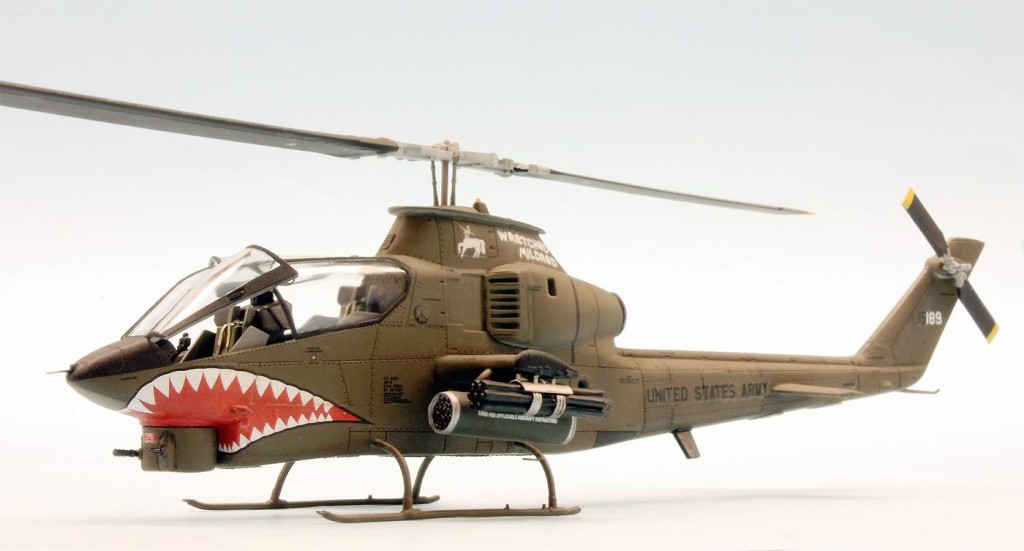

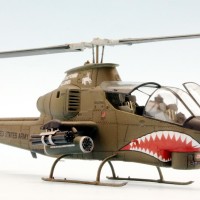
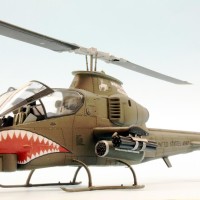
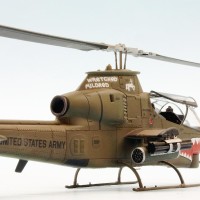
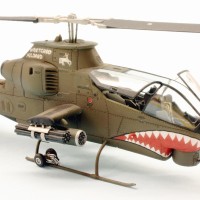
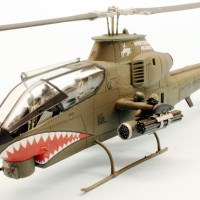
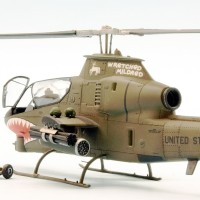

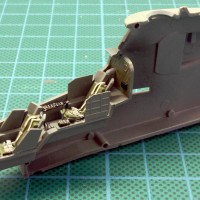
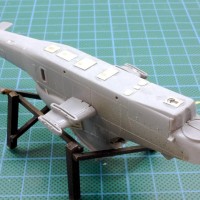
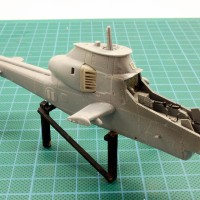
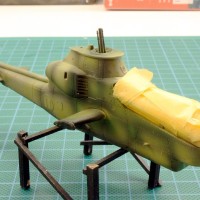
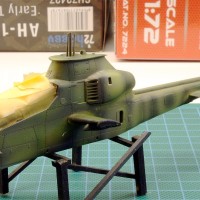
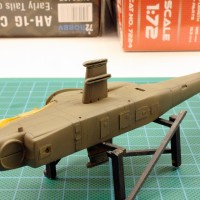
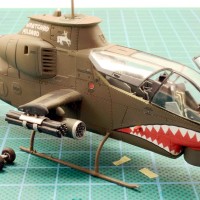
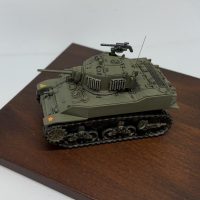
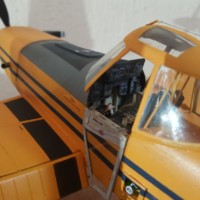
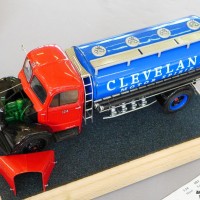
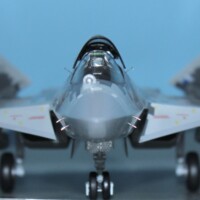
Another superb model, Roland! It is really hard to believe it is only 1/72!
The Cobra is an iconic figure, an extremely effective machine which, as you very well pointed out, proved how effective at times can be to create a new design by utilizing already proven parts at some areas.
It has been stated that the Cobra is not that inferior to its "modern" counterpart, the Apache: in fact, a number of sources state that in combat conditions the venerable and tough cobra still has many advantages over the more complex Apache and there might be some truth behind these statements!
Nevertheless, thank you so much for providing us, once again, with such a wonderful writeup, together with your wonderful model.
Thank you for your feedback, I'm glad to hear it! This really is a topic that becomes more and more exciting the more you read into it.
Great looking Cobra, Roland @rosachsenhofer
Although I have never seen one in real, not even static, this helicopter has impressed me a lot.
Such a sleek looking aircraft with a huge amount of fire power, really impressive.
You did great on this tiny copter.
Thank you for this motivation!
That is one great build, and a mean looking snake Roland.
Thank you for your words Triet!
Great looking model.
Congratulations!
Thank you a lot!
Really nice. Special Hobby is going to release a 1/48 version of this kit.
Thank you Tom! Yes, that would be appealing, with the ICM model you would have three Cobras in three scales to compare- I'm really thinking about it!
Lovely build of this icon! I remember building one of these as a kid (not the Special Hobby kit of course!).
Thank you Greg for your kind words! Indeed, for me as a kid building a "Hue Cobra" -can´t imagine which brand- together with my elder brother is one of my first modeling- memories. How times have changed!
Beautiful build Roland - I love this helicopter. You made it so nicely. Love it man.